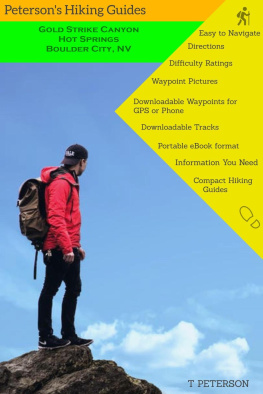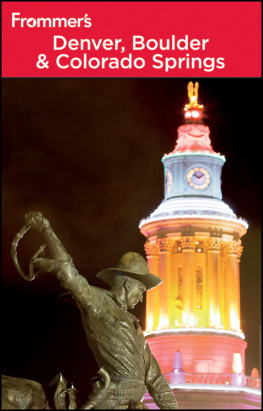Petersons
Hiking Guides

Goldstrike Canyon Hot Springs
Boulder City, NV
A fter hiking in and around Las Vegas (Nevada), Arizona, Utah, Wyoming and California for over thirty years we thought it was time to retrace many of the places weve visited and present them in such a fashion they can be used as a tool for others to enjoy.
Instead of a full book with additional information about amenities, hotels and such, we thought it best to provide hiking guides with either single or multiple, close-together hikes so you may fully enjoy your area of interest. Theres no need to carry bulky books or torn book pages, keep our information on your favorite device. Well leave accommodations, restaurant, and other amenity information to the experts in their field.
We also publish many hikes which are not on developed trails, so it is wise to carry a GPS and/or a Topo map of the area. All the trails in these guides are down-loadable in the form of KMZ and KML files so you can copy them onto your phone or GPS device. We will let you know in the guide whether a GPS is recommended.
Included are minor descriptions of the area, how to get there, and where/when to start are all in the guide. Its suggested you follow the instruction provided, although many people veer from the course and go off on their own. Most areas are easy to navigate and difficult to lose oneself, but there is always the possibility you may find yourself completely turned around. On most of the pictures are way-points. If you do not download the included KMZ or KML file, then you will want to program the way-points into whatever GPS system youre using.
We accept NO responsibility for your travels and/or the accuracy of these guides. We use diligence to verify our information, but you must rely on your own intellect and preparation. We are by no means experts in the field of hiking, survival, or navigation. We provide this information for your enjoyment purposes only and you are responsible for your actions and outcomes from using the information in our guides.
A considerable amount of work goes into the production of each of these guides. We do our best to ascertain and use the correct tools, from a guides point-of-view, to assist in your safety, but there are always unknowns. Several of our trails are one-way only, in other words, the KMZ file is not a loop. You will simply backtrack. If using your GPS device, you must know how to backtrack with your GPS if you're on an unmarked or unmaintained trail. We do let you know if the down-loadable GPS trail is a loop or one way and whether a GPS is required.

B e prepared and stay alive.
Always remember, Proper Planning Prevents Piss Poor Performance - the 6 Ps.
Copyright (c) 2019 - T Peterson
A ll rights reserved . This book or parts thereof may not be reproduced in any form, stored in any retrieval system other than for your personal use, or transmitted in any form by any means electronic, mechanical, photocopy, recording, or otherwise without prior written permission of the publisher, except as provided by the United States of America copyright law. For permission request, send an email to the publisher at the address below. No liability is assumed for losses or damages due to the information provided. You are responsible for your choices, actions, and results.
Feedback Welcome at
Petersons.trails@gmail.com
C LASS1: Class 1 hiking is defined as a well-marked low-risk trail. There is little-to-no chance of becoming lost. The trail is usually maintained and clear of debris. It can be hiked by most nimble persons who can move freely without aid.
CLASS2: Class 2 hiking is more difficult. You may occasionally need to use your hands to move through your route and/or to keep your balance. There may be exposure, hiking on scree, over boulders, and loose rock. There may be considerable elevation gain. The route may be obscured from time-to-time.
CLASS3: Class 3 hiking may include bouldering, hanging onto sides of cliffs, and heavy use of your hands. There may be steep ascends and descents. Possibly loose gravel and scree. A probability of cliff danger and other hazards.
CLASS4: Class 4 hiking includes the information from the previous three class versions plus the possible necessity of use with ropes. Often very steep terrain and a very reasonable possibility of death due to falls. Handholds and footholds are often necessary and other dangers may exist.
CLASS5: A Class 5 hike often requires technical climbing knowledge. You will likely use ropes and belaying. This is often called Rock Climbing instead of hiking. Rock climbs are also designated with a decimal number following the 5 which range from 5.1 to 5.14. The definitions were expanded to include interim difficulty levels, a, b, c, and d. For example, a climb might be rated as 5.11c which is more difficult than a 5.11b.
Difficulty Level1: 0 to 49 - usually three miles or less, very easy, possibly a small incline. Almost anyone can enjoy a Level1 hike.
Difficulty Level2: 50 to 100 - suitable for the novice. A minor challenge and only a moderate incline. May have some steep sections during the hike.
Difficulty Level3: 100 to 150 - somewhat strenuous. Often steep inclines, distance to ten miles, possibly challenging for unconditioned hikers.
Next page










